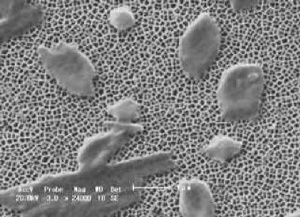Mar 5 2009
Microscopic particles of carbon known as buckyballs may be able to keep the nation's water pipes clear in the same way clot-busting drugs prevent arteries from clogging up.
 This is a membrane without buckyball treatment. Credit: Duke University
This is a membrane without buckyball treatment. Credit: Duke University
Engineers at Duke University have found that buckyballs hinder the ability of bacteria and other microorganisms to accumulate on the membranes used to filter water in treatment plants. This attribute leads the researchers to believe that coating pipes and membranes with these nanoparticles may prove to be an effective strategy for addressing one of the major problems and costs of treating water.
"Just as plaque can build up inside arteries and reduce the flow of blood, bacteria and other microorganisms can over time attach and accumulate on water treatment membranes and along water pipes," said So-Ryong Chae, post-doctoral fellow in Duke's environmental and civil engineering department. The results of his experiments were published March 5, 2009 in the Journal of Membrane Sciences.
"As the bacteria build up on these surfaces, they attract other organic matter, creating a biofilm that slowly builds up over time," Chae continued, "The results of our experiments in the laboratory indicate that buckyballs may be able to prevent this clogging, known as biofouling. The only other options to address biofouling are digging up the pipes and replacing the membranes, which can be expensive and inconvenient."
A buckyball, or C60, is one shape within the family of tiny carbon shapes known as fullerenes. They are named after Richard Buckminster Fuller, the inventor of the geodesic dome, since their shape resembles his famous structure.
"Biofouling is viewed as one of the biggest costs associated with membrane-based water treatment systems," said Claudia Gunsch, assistant professor of civil engineering at Duke's Pratt School of Engineering and senior member of the research team. "These membranes have very small pores, so they can get stopped up quickly. If we could increase the time between membrane replacements by 50 percent, for example, that would be a huge cost savings."
According to Chae, the addition of buckyballs to treatment membranes had a two-fold effect. First, treated membranes showed less bacterial attachment than non-treated membranes. After three days, the membranes treated with buckyballs had on average 20 colony forming units, the method by which bacterial colonies are counted.
"In contrast, the number of bacterial colonies on the untreated membrane was too numerous to count," Chae said.
Chae also found that the presence of the buckyballs inhibited respiration, or the ability of the bacteria to use oxygen to fuel its activities.
"As the concentration of buckyballs increased, so did the inhibition of respiration," Chae said. "This respiratory inhibition and anti-attachment suggests that this nanoparticle may be useful as an anti-fouling agent to prevent the biofouling of membranes or other surfaces."
Gunsch said the mechanisms involved are not well-understood.
Both Gunsch and Chae believe that since buckyballs are one of the most widely used nanoparticles, additional research is needed to determine if they have any detrimental effects on the environment or to humans. This is one of many issues being studied at Duke's Center for Environmental Implications of Nanotechnology.
"We need to figure out how resistant these coatings will be to long-term use," Gunsch said. "If they can indeed prevent fouling, they will last longer. If they slough off over time, we need to know what the effects will be."
The current experiments in the laboratory were conducted with Escherichia coli K12, a strain of the bacteria that is widely used in laboratory experiments.
"We focused on a quite specific microorganism, so the next stage of our research will to see if these nanoparticles will have the same effects on bacteria commonly found in the environment or those in mixed microbial communities," Chae said. "We also plan to build a small-scale version of a treatment plant in the lab to conduct these tests."
The research was supported by the Office of Naval Research, National Science Foundation and the Korea Research Foundation. Other Duke members of the team were Shuyi Wang, Zachary Hendren and Mark R. Wiesner. Yoshimasa Watanabe, Hokkaido University, Japan, was also part of the team.